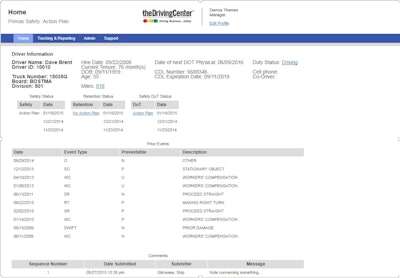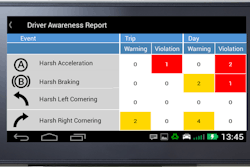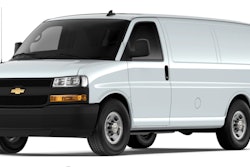A growing number of driver performance management systems now have the option to deploy cameras and video event recorders. Using this technology, many fleets are broadening the spectrum of driving behaviors they can monitor and assess.
 The Driver Center portal from Omnitracs brings together driver performance data from multiple sources.
The Driver Center portal from Omnitracs brings together driver performance data from multiple sources.Early generations of video event recorders— going back no more than a decade — were designed to transmit video clips and data records only when certain exceptions were detected from the sensor data of accelerometers (g-force) and vehicle electronics.
Recent developments are focused on applying machine vision to expand the number and complexity of exceptions for driving behaviors that contribute to accidents and poor performance.
Machine vision goes beyond sensor data by using software algorithms to detect patterns of risk from the video itself. Assessing driver behaviors at stop signs is one of many possibilities.
Did the driver stop?
Omnitracs is working on a feature for its Critical Event Video (CEV), an option for its in-cab fleet management platform, to monitor driver behaviors at stop signs and stop lights.
CEV uses an outward and optional inward-facing camera to capture and transmit video of safety-critical events such as sudden deceleration and speeding.
With the new feature, Omnitracs CEV will be able to ascertain if a driver stopped at an intersection where a stop sign or light was present. Engineers are working on algorithms that will compare the vehicle’s speed and position to a database of stop sign locations, as well as use machine vision to detect stop signs, says Lauren Dominick, senior director of analytics and modeling.
Omnitracs is also working on new machine vision algorithms that will use video from its inward-facing camera to detect patterns of driver distraction. Examples include eye movement, cell phone and seat belt usage, she says.
Simplifying video reviews
While cameras add another layer to managing driver performance, the volume of information can also present new challenges.
“It is unreasonable to review every video stored or captured,” she says.
 Omnitracs channels data from electronic logging devices and transportation management software systems for its ELD Driver Retention model that relies on predictive analytics to provide alerts for drivers whose profiles present red flags.
Omnitracs channels data from electronic logging devices and transportation management software systems for its ELD Driver Retention model that relies on predictive analytics to provide alerts for drivers whose profiles present red flags.To help fleets more efficiently manage driver behaviors, Omnitracs is working on a feature for its CEV platform that will prioritize video events for review by fleets, depending on what areas of performance they are interested in, she explains.
For example, if a fleet wants to run a safety campaign on seatbelt use, safety managers can review a daily scorecard of drivers to quickly identify videos of those having problems in that area.
Omnitracs also has an online Driver Center that presents a dashboard of key metrics for driver performance. The Driver Center is the interface for Omnitracs’ predictive models for accidents, driver turnover and fatigue.
The predictive models for driver safety and turnover can be customized to fleets’ needs to be “as complex or simple as the client wants it,” she says.
The data can come from its own fleet management platforms and from other databases that fleets use.
“We’ll take data in any format,” says Dominick.
The Driver Center identifies drivers that a fleet should focus on to prevent accidents or turnover, depending on the predictive models the fleet uses, and the reasons why the drivers are at risk, she explains.
For example, the company’s ELD Driver Retention model predicts which drivers in a fleet will be next to quit based on more than 1,000 variables derived from hours-of-service data. Some of the top predictors for turnover are fatigue and variability in work schedules.











